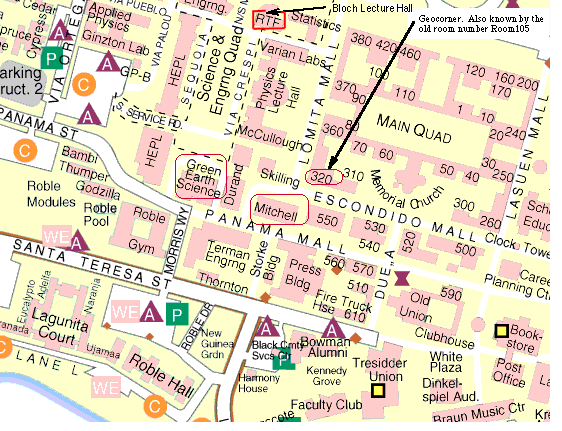see map
Anyone wishing to attend the lecture only is welcome at no cost.
This will be the 331st meeting since 1954.

Gary Ernst on the PGS field trip, Pacheco Pass. Photograph by Mike Diggles, November, 1996
Abstract
The Sawyers Bar area consists of three tectonically juxtaposed supracrustal units: (a) on the east, the Stuart Fork metabasalt + metachert + metagraywacke terrane above the low-angle, east-dipping Soap Creek Ridge thrust; (b) the medial North Fork ophiolitic terrane, comprised of intercalated St. Clair Creek laminated cherts and fine-grained quartzofeldspathic argillites, interstratified with, and overlain by two mafic igneous, largely extrusive suites–North Fork sensu stricto mildly alkaline basalts, and Salmon River basaltic + diabasic + gabbroic arc tholeiites; and (c), the cherty, Eastern Hayfork metagraywacke mélange terrane west of the minor, high-angle Twin Sisters fault. Mineral and bulk-rock elemental + isotopic data, integrated with geologic mapping, document deformation and fluid-rock interaction in the upper few kms of a suprasubduction-zone basaltic arc during tectonic accretion to the western margin of North America or a nearby offshore arc. The following history is advanced: (1) LREE-enriched arc tholeiites + alkaline basalts and distal turbidites of the North Fork + Eastern Hayfork terranes were deposited in a subsea environment during Permian(?), Triassic, and earliest Jurassic time. Landward, subduction resulted in production of the high-P Stuart Fork blueschist complex, then its exhumation at ~227 Ma. (2) Submarine eruption and sedimentation continued outboard during Early and Middle Jurassic time, producing the west-facing North Fork oceanic arc and adjacent, tectonically disrupted Eastern Hayfork mélange. These two terranes underwent low-T alteration by seawater at 100-200 °C and <100 MPa; alkali exchange and modest Mg-enrichment were accompanied by increases in greenstone bulk-rock ![]() 18O values from 6 to ~10‰, preceeding and during initial stages of island-arc formation at 175-200 Ma. By the end of this time, the outboard Western Hayfork calc-alkaline arc had accreted to the Eastern Hayfork terrane. (3) Suturing of the North Fork oceanic arc beneath the exhumed, landward Stuart Fork terrane at 165-170 Ma resulted in regional folding and ~sub- to greenschist-facies metamorphism. Pervasive recrystallization took place without substantial chemical or isotopic exchange under conditions of 300-425 °C, 300 ± 100 MPa, higher metamorphic grade in the north, lower in the south. (4) East-descending subduction or transpression continued seaward, and granitoid plutons were emplaced locally during 159-164 Ma, heating adjacent wall rocks to a maximum of ~500-600 °C at pressures of 200-300 MPa. The temperature increase caused devolatilization of metasediments and the exchange of high
18O values from 6 to ~10‰, preceeding and during initial stages of island-arc formation at 175-200 Ma. By the end of this time, the outboard Western Hayfork calc-alkaline arc had accreted to the Eastern Hayfork terrane. (3) Suturing of the North Fork oceanic arc beneath the exhumed, landward Stuart Fork terrane at 165-170 Ma resulted in regional folding and ~sub- to greenschist-facies metamorphism. Pervasive recrystallization took place without substantial chemical or isotopic exchange under conditions of 300-425 °C, 300 ± 100 MPa, higher metamorphic grade in the north, lower in the south. (4) East-descending subduction or transpression continued seaward, and granitoid plutons were emplaced locally during 159-164 Ma, heating adjacent wall rocks to a maximum of ~500-600 °C at pressures of 200-300 MPa. The temperature increase caused devolatilization of metasediments and the exchange of high ![]() 18O fluids with intimately intercalated greenstones;
18O fluids with intimately intercalated greenstones; ![]() 18O values in metavolcanic rocks locally increased to more than 15‰. Subsequent cooling yielded 150-164 Ma apparent mineral ages for the metamorphic aureoles. (5) Minor intrusion took place at the end of Jurassic time, when distinctive muscovite porphyry felsite dikes transected the Stuart Fork-North Fork thrust contact; formation of hydrothermal gold-bearing quartz veins, dated at 147 ± 3 Ma, may be associated with this event. Cenozoic exhumation resulted in range-front faulting and erosion. The documented interplay between Phanerozoic convergence/transpression and petrochemical evolution in a suprasubduction zone setting provides an illuminating model for crustal growth.
18O values in metavolcanic rocks locally increased to more than 15‰. Subsequent cooling yielded 150-164 Ma apparent mineral ages for the metamorphic aureoles. (5) Minor intrusion took place at the end of Jurassic time, when distinctive muscovite porphyry felsite dikes transected the Stuart Fork-North Fork thrust contact; formation of hydrothermal gold-bearing quartz veins, dated at 147 ± 3 Ma, may be associated with this event. Cenozoic exhumation resulted in range-front faulting and erosion. The documented interplay between Phanerozoic convergence/transpression and petrochemical evolution in a suprasubduction zone setting provides an illuminating model for crustal growth.
About the Speaker (click here)
Reservations: The preferred way to make reservations is simply to email Willie Lee at whklee@ix.netcom.com by Friday, November 3, tell him you will attend, commit to pay, and bring your payment to the meeting. A check made to "PGS" is preferred.
If you want to pay in advance:
Stanford faculty and students: Please make dinner reservations by Friday, Friday, November 3. Contact Dr. Juhn Liou via his mailbox (and leave check), Geological and Environmental Sciences Office, Mitchell Bldg. (Rm. 138). Make checks out to "PGS."
All others, including faculty and students from other Bay Area universities and colleges and USGS: Please make dinner reservations by Friday, November 3. Contact Willie Lee, at USGS, MS-977, 345 Middlefield Rd., Menlo Park, CA 94025, phone 650-329-4781. Send check made out to "PGS" to Willie.
Dinner is $25.00. Includes wine (5:30 to 6:15 PM.), dinner (6:15-7:30 PM.), tax, and tip. Note: PGS does not make revenue on this price.

